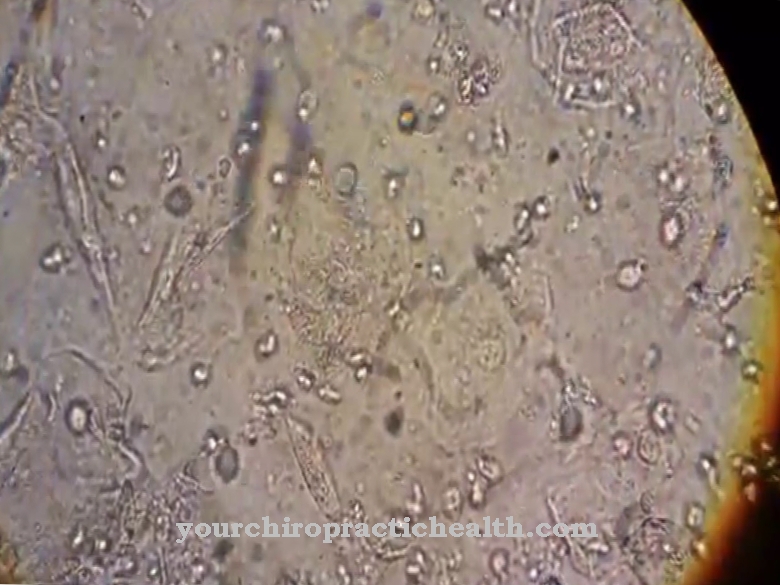Clostridium tetani is a bacterium from the clostridial family and causes the disease tetanus. Tetanus, also known as tetanus, is a wound infection that is often fatal.
What is Clostridium tetani?
The bacterium Clostridium tetani occurs in the intestines of animals (especially herbivores) and humans. The dangerous spores of the pathogen are distributed almost everywhere, e.g. in garden soil or street dust.
The bacterial spores enter the body mainly through deep and air-tight wounds, such as when stepping into a rusty nail. But even the smallest skin injuries, e.g. through a wood splinter can be a gateway for Clostridium tetani.
The source of infection for so-called newborn tetanus is the umbilical wound when the newborn is cut off under non-sterile conditions. Newborn tetanus usually only occurs in developing countries and is the most lethal of all forms of tetanus. The World Health Organization estimates that around 180,000 babies die of tetanus worldwide, and fewer than 15 people develop tetanus each year in Germany.
Transmission from person to person is not possible. Once the pathogen Clostridium tetani has penetrated the body, it takes a few days to two weeks, in rare cases even a few months, before the first symptoms appear. The following applies: the shorter the incubation period, the more severe the disease process.
Meaning & function
Under anaerobic conditions, i.e. if there is a lack of oxygen in the wound, the spores of the Clostridium tetani out, the bacterium multiplies and forms two very dangerous toxins for the body: tetanospasmin and tetanolysin. The poison tetanospasmin reaches the spinal cord via the bloodstream or nerves. There it causes hypersensitivity, increased reflexes and cramps. The toxin tetanolysin damages the blood and the heart muscle.
As a result of this exposure to the toxins, various symptoms arise. At the beginning, those affected tend to show general symptoms such as headache, back pain, muscle pain and fatigue. In addition, feelings of tension in the wound area, sensitivity to light and noise as well as inner restlessness can occur.
If the disease progresses slightly, then locally limited muscle stiffness occurs, especially in the jaw and neck area. However, seizures do not occur.
In the case of more severe infections with Clostridium tetani, the aforementioned muscle stiffness in combination with a high fever is initially evident. However, this is followed by cramps in the muscles. At first the chewing muscles, the tongue muscles and the facial muscles cramp. Due to the cramping of the facial muscles, the patients show the so-called malicious or devil grin.
Then there are cramps in the neck muscles, extremities and abdominal muscles. Sick people usually freeze in a stretched position. The cramps are triggered by the slightest visual or acoustic stimuli.
During these very painful seizures, the affected person is fully conscious.
Diseases
Possible complications of being infected with Clostridium tetani are pneumonia, torn muscles, dislocated bones and broken bones (caused by the seizures) as well as any remaining muscle shortening, joint stiffness and curvature of the spine.
Death occurs either from asphyxiation caused by paralysis of the muscles of the tongue, throat, larynx, or diaphragm, or from cardiovascular failure.
In the severe form, 50% of all infections with Clostridium tetani are fatal despite vaccination. Without vaccination, mortality in the severe form is 90%. The early administration of an antitoxin is crucial. The patients receive intensive medical care. With the help of sedatives, muscle-relaxing medication and artificial respiration, the sick will be relieved. If possible, patients are accommodated in a soundproof and darkened room to prevent seizures.
Recovery after surviving an infection with Clostridium tetani only takes a few days in mild cases. In severe cases, convalescence can take several weeks to months. An illness with tetanus does not leave enough antibodies, so that a new illness is possible.
A possible protection against infection with Clostridium tetani is a tetanus vaccination. In infants and toddlers, there is usually a basic immunization, which then has to be refreshed every 10 years. In particular, people over 60 years of age should pay attention to their vaccination protection, since the antibodies against the bacterium break down faster with increasing age.

























.jpg)


